History |
Palmer Fuller & Co. is the best name of a millwork business in Chicago that was one of the earliest to distribute millwork by rail. The company is known today for its two millwork catalogs posted at archive.org. The company's forerunner was established circa 1853, and Palmer Fuller closed its doors in 1906.
The business traces back to a Chicago millwork firm named Goss & Abbott. Daniel Goss (1810-1879), one of the partners, specialized in early machines and patented a press used to create rope out of hemp (Glasgow [Missouri] Weekly Times, 5/17/1849). Born in Massachusetts, Goss moved to Chicago in 1848. Goss & Abbott had a factory at the intersection of Clark and Twelfth Streets in Chicago and a sale room at 189 Randolph Street. The partnership was dissolved in early 1855 (Moline [Illinois] Workman, 3/28/1855).
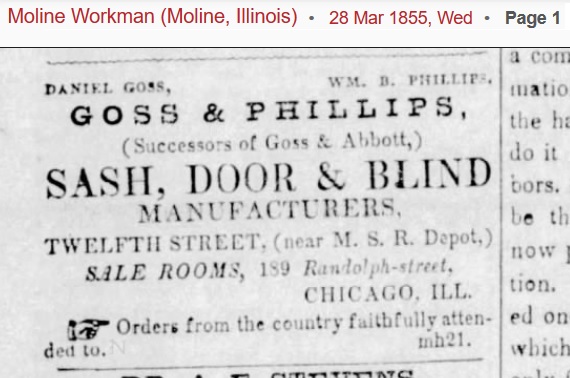
In early 1855 Goss entered into a new partnership with his son-in-law William B. Phillips, named "Goss & Phillips". The factory in which sash was produced burned in 1856 when a fire that began at a freight depot spread to adjacent buildings (Ottawa [Illinois] Free Trader, 8/16/1856). A new factory was built in early 1857 (Chicago Tribune, 6/9/1857). The firm had moved its sales room to 42 Franklin Street by mid-1857 (Wisconsin State Journal, 9/19/1857). The partners reached an impasse in late 1861 and dissolved the business (Chicago Tribune, 1/18/1862), with Phillips operating out of the previous buildings. The fissure was repaired and the partnership resumed after two months (Chicago Tribune, 3/4/1863). At the beginning of 1866, the partnership was expanded by the addition of Azariah R. Palmer and William A. Fuller, at which time the business name was adjusted to "Goss, Phillips & Co." (Chicago Tribune, 1/20/1866). However, the partners again reached an impasse in late 1866, and the partnership dissolved effective New Year's Day of 1867 (Chicago Tribune, 1/15/1867). The Goss & Phillips company and the Palmer, Fuller & Co. both opened new businesses at 12th and Clark Streets (Daily Journal of Commerce, 5/13/1871).
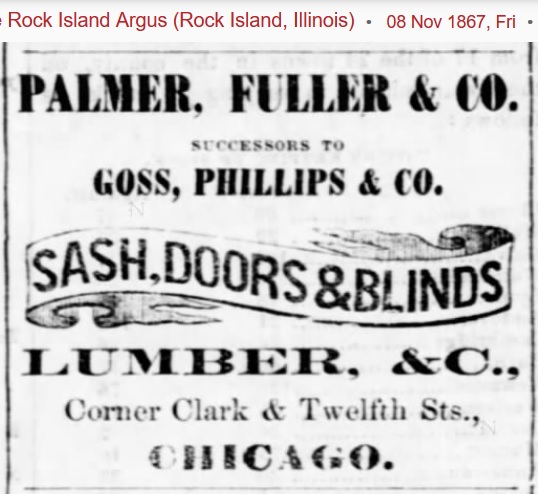
Palmer, Fuller & Co. officially opened its doors on New Year's Day of 1867, operating out of the buildings formerly used by Goss & Phillips. An early event of note took place on 5/2/1867 when a crowd of 200 men gathered outside of the planing mill at 8 am to protest for a general 8-hour working day among various businesses in Chicago. The management decided to close the mill that day, and the protesters moved on to protest outside of other businesses (Chicago Tribune, 5/3/1867). In 1871, Palmer Fuller constructed a new factory complex in Chicago's "lumber district," at the intersection of West 22d Street and Union Station (Chicago Tribune, 3/11/1871). This factory was one of the earliest millwork concerns in the nation that used a machine invented by L.S. Hicks that created tenons on both ends of a piece of wood at the same time (Chicago Tribune, 5/10/1871).
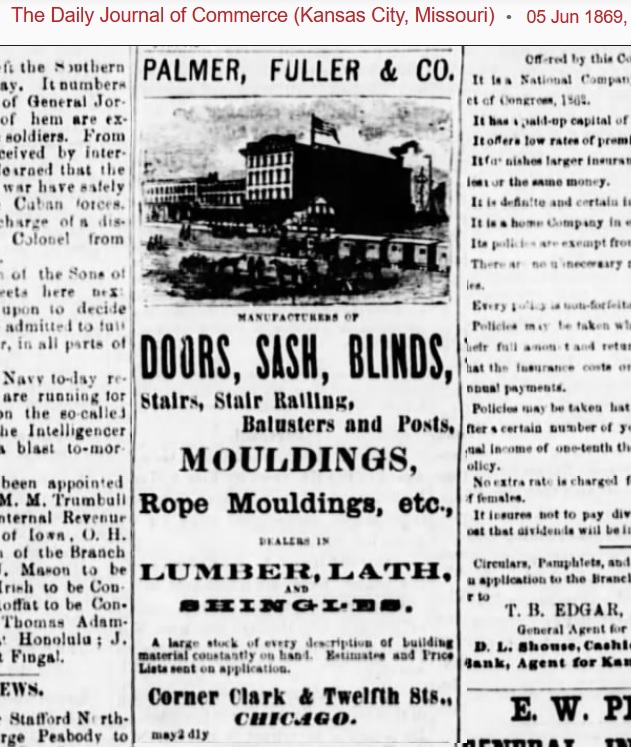
The Chicago Tribune ran a series of thumbnail sketches of companies in the city in 1873. Its paragraph about Palmer Fuller states: "Palmer, Fuller and Co., manufacturers of moldings, sash, doors, blinds and stair railings and dealers in lumber, etc., are at the corner of W. Twenty-second and Union. They occupy six acres of ground and use about 1,000,000 feet of the better grades of lumber per month. They employ over 400 men. They have the most convenient and capacious of any factory of the kind in the United States. Six dry kilns of the most approved arrangement are in use. The firm have just discharged at their dock from one vessel the largest load of lumber ever brought to this market, containing of board measure 1,025,000 feet" (Chicago Tribune, 8/14/1873).
The company endured a difficult time in the mid-1870s but then bounced back. A.R. Palmer's health began to fail in early 1874, and he embarked upon a travel to distant lands to restore his health. During these travels, Palmer died in Newbury, Vermont (Chicago Tribune, 5/7/1874). In 1876, Chicago workers began a general strike that lasted with fits and starts into 1877. Palmer Fuller offered the workers a raise to $1.25 a day in early 1876, which the workers rejected (Chicago Inter Ocean, 5/10/1876). It appears that Palmer Fuller soon thereafter reached an agreement with workers, because later reports of the strike only reference the company as operating in the vicinity of the protests (for example, Indianapolis News, 7/25/1877). During the course of the strike, Palmer Fuller became the first Chicago millwork firm to ship a set of millwork to Australia - it was a large order including enough doors to fill a railroad car (Bloomington, Illinois Pantagraph, 6/22/1877).
Two important events took place in the history of Palmer Fuller in early 1879. In the winter, the company published its earliest known millwork catalog (see image below). The catalog is primarily a price list, although it includes some images of windows, porch elements, stair pieces, mantels, and fences. Then in the spring of 1879, a large fire in six Palmer Fuller dry kilns resulted in the burning of a large portion of the lumber district in southwestern Chicago. In addition to the loss of the Palmer Fuller kilns, a large exterior pile of wood shingles burned nearby. The progress of the fire was retarded by a new fire alarm system and hydrants that had recently been installed and had never been used (Chicago Tribune, 5/12/1879). Many newspapers ran articles on this fire.
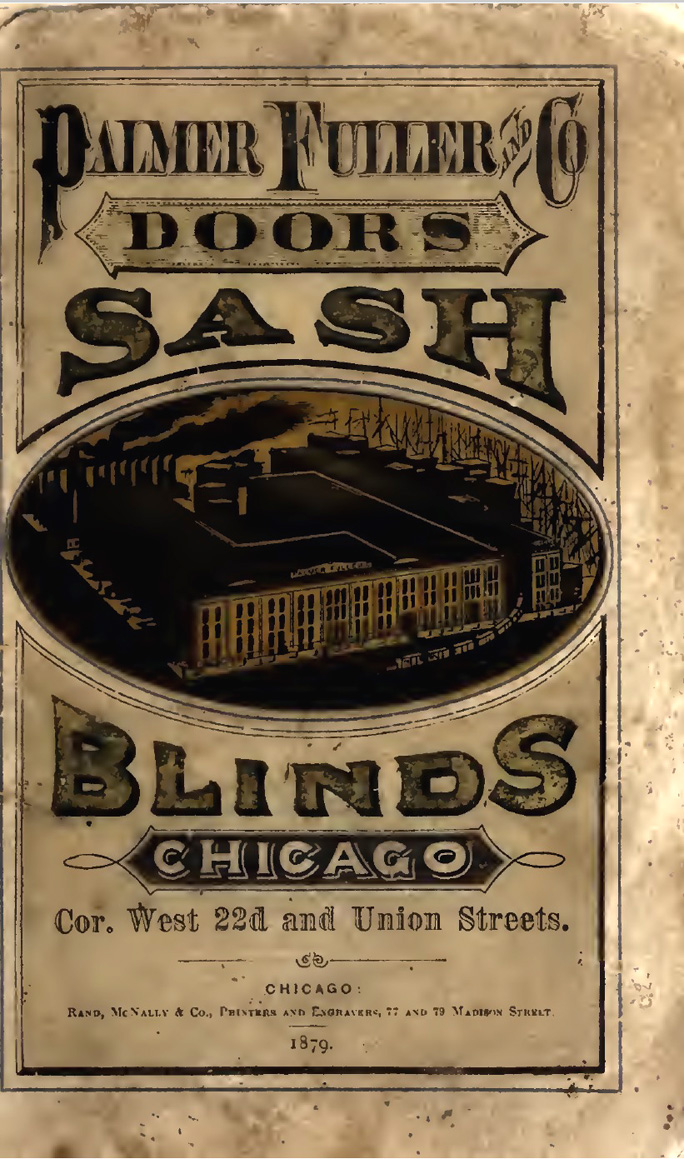
The 1880s were a prosperous time for Palmer Fuller. An 1883 article outlining the strong economy of Chicago referenced "Palmer, Fuller & Co., who are acknowledged to manufacture and sell more sash, doors, blinds, and hardwood interior-finish goods than any other establishment in the world..." as one in a list of prominent Chicago firms (Chicago Tribune, 1/1/1883). In 1889, the company issued another millwork catalog that survives (cover shown below). The catalog was similar to its 1879 version, consisting primarily of tables of prices for windows and doors of various sizes. It included a larger number of illustrations of doors and was one of the earliest catalogs to show cottage doors.
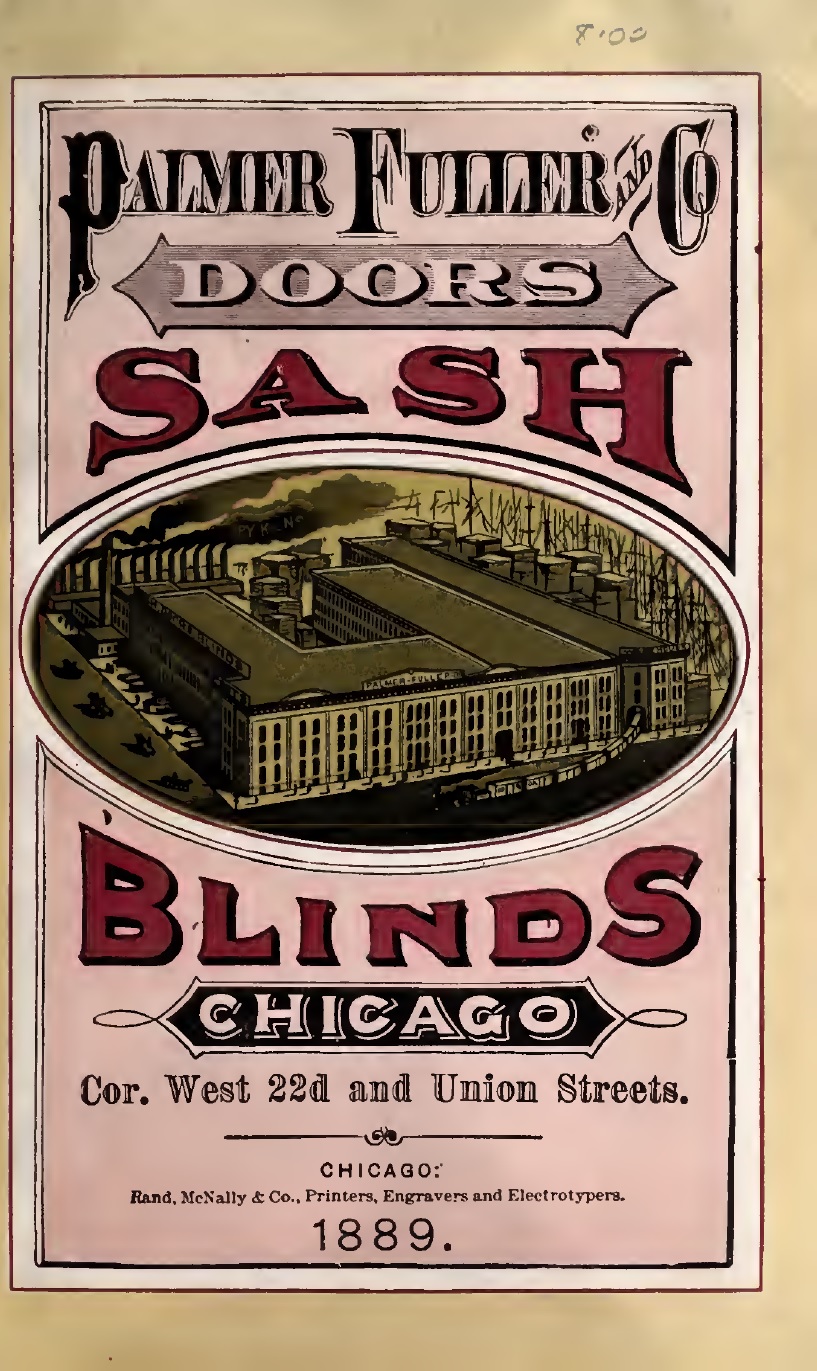
The 1890s were difficult for Palmer Fuller. Although the company agreed to reduce hours of operation to eight-hour shifts with the same pay as the former nine-hour shifts, labor disputes continued. Part of the problem was that rising wages in Chicago meant that it was cheaper for the company to purchase wholesale goods that were shipped in by rail. The company's last known catalog was published in 1892. In 1897, the Palmer Fuller manufacturing operations ceased altogether, and two years later the company's factory was leased to S. Karpen & Brothers (Chicago Tribune, 2/25/1899). William A. Fuller, who had been serving as company president, left the company circa 1900; a newspaper notice in 1903 identified him as "William A. Fuller, formerly of Palmer, Fuller & Co." (Chicago Tribune, 3/5/1903).
Palmer Fuller declined in importance in the early twentieth century. Having made the transition from millwork production to millwork distribution, the company faced the challenge of making money selling millwork purchased at the wholesale rate when other millwork production companies were marketing their goods to the same customers at wholesale prices. Then in early 1906, banks began to return Palmer Fuller checks for insufficient funds. John R. Laing, who had served as the company's president since 1883, withdrew money from the company accounts in various banks, and eventually it emerged that he had withdrawn $30,000. Laing disappeared with the money and did not raise suspicion until three weeks later when the remaining company funds in the banks were exhausted (Chicago Tribune, 1/30/1906). E.L. Roberts agreed to serve as receiver for the company. The company's assets consisted of millwork on hand and buildings, which Roberts liquidated, ending the Palmer Fuller & Company.
Millwork catalogs at archive.org:
1879,
1889
|




